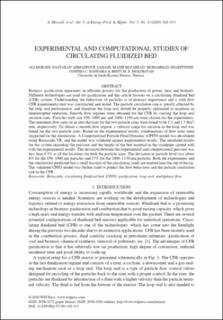| dc.contributor.author | Moradi, Ali | |
| dc.contributor.author | Samani, Nastaran Ahmadpour | |
| dc.contributor.author | Mojarrad, Masih | |
| dc.contributor.author | Sharfuddin, Mohammad | |
| dc.contributor.author | Bandara, Janitha | |
| dc.contributor.author | Moldestad, Britt Margrethe Emilie | |
| dc.date.accessioned | 2021-09-20T11:55:44Z | |
| dc.date.available | 2021-09-20T11:55:44Z | |
| dc.date.created | 2020-11-12T12:35:37Z | |
| dc.date.issued | 2020 | |
| dc.identifier.citation | Moradi, A., Samani, N. A., Mojarrad, M., Sharfuddin, M., & Moldestad, B. M. (2020). Experimental and computational studies of circulating fluidized bed. International Journal of Energy Production and Management, 5(4), 302-313. | en_US |
| dc.identifier.issn | 2056-3272 | |
| dc.identifier.uri | https://hdl.handle.net/11250/2779199 | |
| dc.description.abstract | Biomass gasification represents an efficient process for the production of power, heat and biofuels. Different technologies are used for gasification and this article focuses on a circulating fluidized bed (CFB) system. Understanding the behaviour of particles is of primary importance and a cold flow CFB experimental unit was constructed and tested. The particle circulation rate is greatly affected by the loop seal performance, and therefore the loop seal should be properly optimized to maintain an uninterrupted operation. Smooth flow regimes were obtained for the CFB by varying the loop seal aeration rates. Particles with size 850–1000 µm and 1000–1180 µm were chosen for the experiments. The minimum flow rates of air into the riser for the two particle sizes were found to be 1.3 and 1.5 Sm3/ min, respectively. To obtain a smooth flow regime, a velocity range for aeration in the loop seal was found for the two particle sizes. Based on the experimental results, combinations of flow rates were suggested for the simulations. A Computational Particle Fluid Dynamic (CPFD) model was developed using Barracuda VR, and the model was validated against experimental results. The simulated results for the system regarding the pressure and the height of the bed material in the standpipe agreed well with the experimental results. The deviation between the experimental and computational pressure was less than 0.5% at all the locations for both the particle sizes. The deviation in particle level was about 6% for the 850–1000 µm particles and 17% for the 1000–1150 µm particles. Both the experiments and the simulations predicted that a small fraction of the circulating sands are emitted from the top of the rig. The validated CPFD model was further used to predict the flow behaviour and the particle circulation rate in the CFB. | en_US |
| dc.language.iso | eng | en_US |
| dc.title | Experimental and computational studies of circulating fluidized bed | en_US |
| dc.type | Journal article | en_US |
| dc.type | Peer reviewed | en_US |
| dc.description.version | publishedVersion | en_US |
| dc.rights.holder | © 2020 WIT Press. | en_US |
| dc.source.pagenumber | 302-313 | en_US |
| dc.source.volume | 5 | en_US |
| dc.source.journal | International Journal of Energy Production and Management | en_US |
| dc.source.issue | 4 | en_US |
| dc.identifier.doi | https://doi.org/10.2495/EQ-V5-N4-302-313 | |
| dc.identifier.cristin | 1847377 | |
| cristin.ispublished | true | |
| cristin.fulltext | original | |
| cristin.qualitycode | 1 | |
